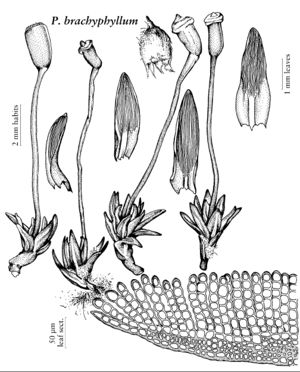Difference between revisions of "Pogonatum brachyphyllum"
Prodr. Aethéogam., 84. 1805,.
FNA>Volume Importer |
FNA>Volume Importer |
||
| Line 24: | Line 24: | ||
|elevation=low to moderate elevations | |elevation=low to moderate elevations | ||
|distribution=Ala.;Ark.;Fla.;Ga.;Ill.;Ind.;Kans.;La.;Md.;Miss.;Mo.;N.J. N.Y.;N.C.;S.C.;Tenn.;Tex.;Va. | |distribution=Ala.;Ark.;Fla.;Ga.;Ill.;Ind.;Kans.;La.;Md.;Miss.;Mo.;N.J. N.Y.;N.C.;S.C.;Tenn.;Tex.;Va. | ||
| − | |discussion=<p>Pogonatum brachyphyllum is endemic to eastern North America, and it has a more southerly distribution than P. pensilvanicum. The leaves of P. brachyphyllum are entire, short and broad, and appear succulent because of tall, closely packed lamellae. The calyptra is yellowish to reddish brown, contrasting with the rich, green protonemal mat.</p> | + | |discussion=<p><i>Pogonatum brachyphyllum</i> is endemic to eastern North America, and it has a more southerly distribution than <i>P. pensilvanicum</i>. The leaves of <i>P. brachyphyllum</i> are entire, short and broad, and appear succulent because of tall, closely packed lamellae. The calyptra is yellowish to reddish brown, contrasting with the rich, green protonemal mat.</p> |
|tables= | |tables= | ||
|references= | |references= | ||
| Line 47: | Line 47: | ||
|publication year= | |publication year= | ||
|special status= | |special status= | ||
| − | |source xml=https://jpend@bitbucket.org/aafc-mbb/fna-data-curation.git/src/ | + | |source xml=https://jpend@bitbucket.org/aafc-mbb/fna-data-curation.git/src/8f726806613d60c220dc4493de13607dd3150896/coarse_grained_fna_xml/V27/V27_195.xml |
|genus=Pogonatum | |genus=Pogonatum | ||
|species=Pogonatum brachyphyllum | |species=Pogonatum brachyphyllum | ||
Revision as of 16:53, 18 September 2019
Plants small, scattered on a deep-green, persistent protonema, dull green to red-brown with age. Stems 0.2–0.3 cm. Leaves 1.5–3 mm, incurved at the tips when dry, erect-spreading when moist, gradually tapering to the blade; sheath oblong, entire, not hyaline-margined, the zone of incrassate hinge-cells at the shoulders not sharply defined; blade lanceolate, broadly and bluntly pointed, appearing turgid and fleshy, entire; marginal lamina erect, narrow, 1-stratose; costa ending in the tip, smooth abaxially; lamellae 25–40, entire in profile, 7–12 cells high, the marginal cells in section rounded, often thicker-walled, smooth; sheath cells short-rectangular; cells on the abaxial surface of blade 14–17 µm wide, thick-walled, longitudinally elongate in the median portion, subquadrate to either side. Seta (0.5–)1.5–2.5 cm, reddish, often twisted below the capsule. Capsule 2–2.5 mm, ± asymmetric, suberect to inclined to almost horizontal; operculum with a convex base and a short, rather blunt beak; exothecium mammillose, the cells short-rectangular, thick-walled; peristome to 300 µm, deeply divided almost to the capsule rim, the teeth reddish with hyaline margins. Spores 13–18 µm.
Habitat: Bare sandy or clayey soil on banks of ditches or streams, usually in open situations
Elevation: low to moderate elevations
Distribution

Ala., Ark., Fla., Ga., Ill., Ind., Kans., La., Md., Miss., Mo., N.J. N.Y., N.C., S.C., Tenn., Tex., Va.
Discussion
Pogonatum brachyphyllum is endemic to eastern North America, and it has a more southerly distribution than P. pensilvanicum. The leaves of P. brachyphyllum are entire, short and broad, and appear succulent because of tall, closely packed lamellae. The calyptra is yellowish to reddish brown, contrasting with the rich, green protonemal mat.
Selected References
None.
